Revenue Management Assignment
VerifiedAdded on 2021/06/18
|11
|2955
|125
AI Summary
Contribute Materials
Your contribution can guide someone’s learning journey. Share your
documents today.
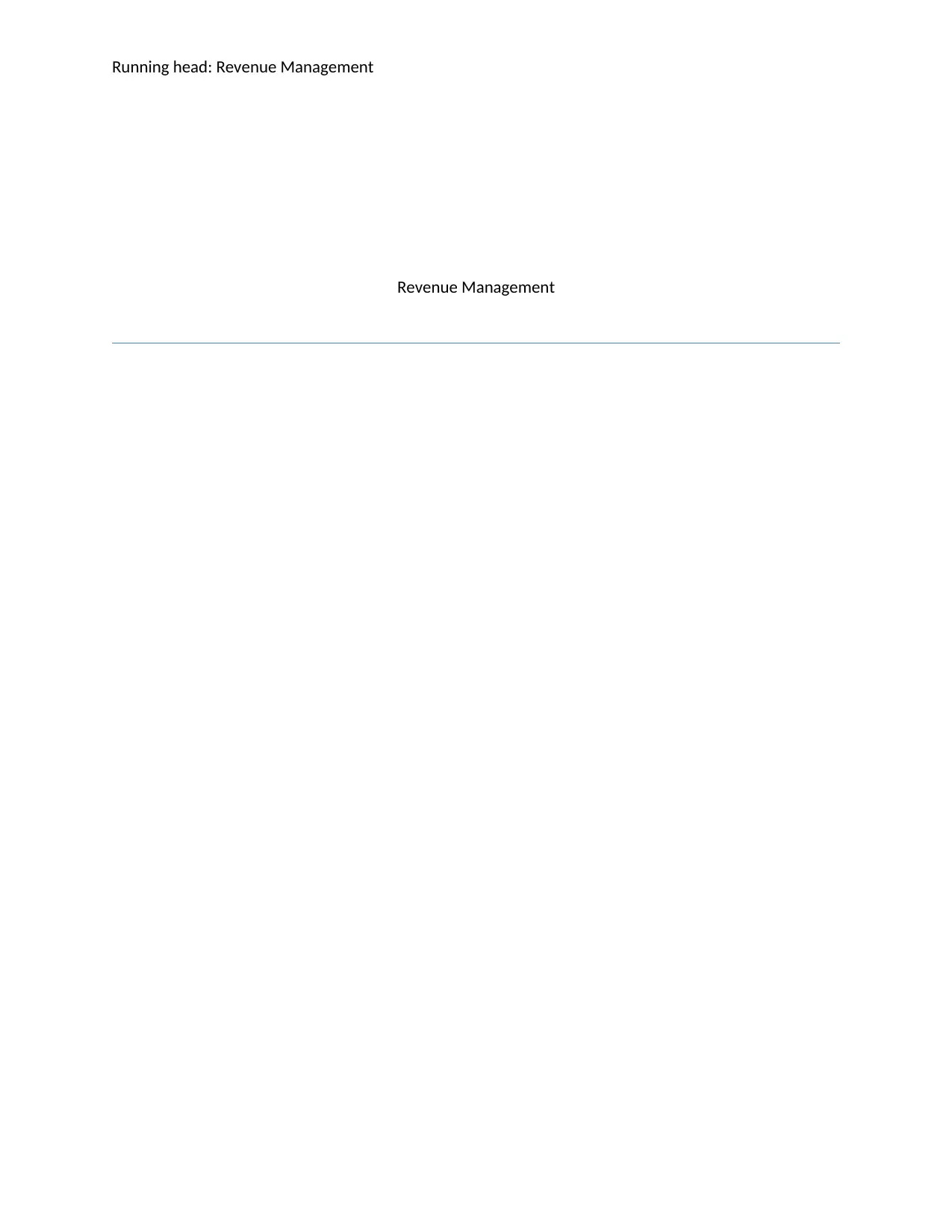
Running head: Revenue Management
Revenue Management
Revenue Management
Secure Best Marks with AI Grader
Need help grading? Try our AI Grader for instant feedback on your assignments.
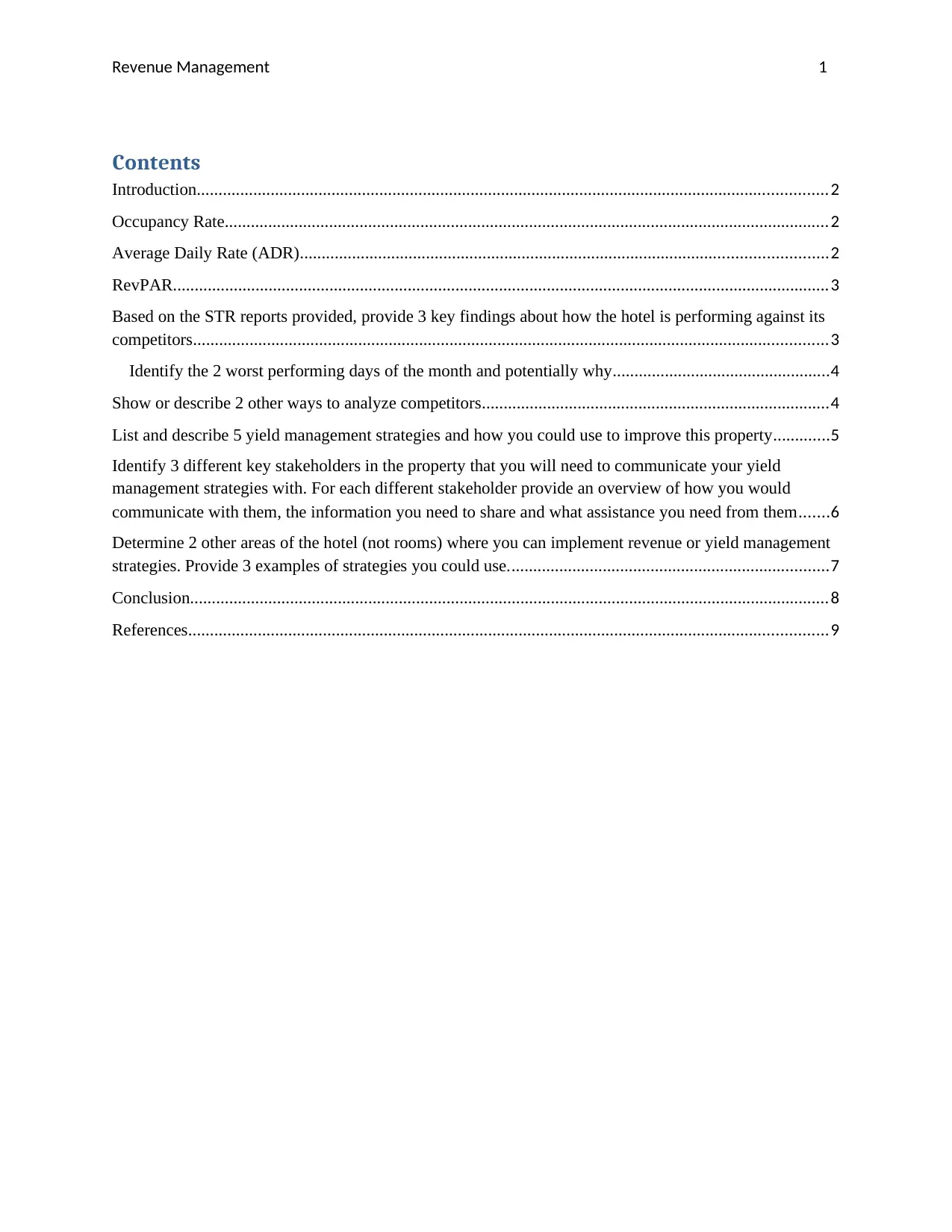
Revenue Management 1
Contents
Introduction.................................................................................................................................................2
Occupancy Rate...........................................................................................................................................2
Average Daily Rate (ADR).........................................................................................................................2
RevPAR.......................................................................................................................................................3
Based on the STR reports provided, provide 3 key findings about how the hotel is performing against its
competitors..................................................................................................................................................3
Identify the 2 worst performing days of the month and potentially why..................................................4
Show or describe 2 other ways to analyze competitors................................................................................4
List and describe 5 yield management strategies and how you could use to improve this property.............5
Identify 3 different key stakeholders in the property that you will need to communicate your yield
management strategies with. For each different stakeholder provide an overview of how you would
communicate with them, the information you need to share and what assistance you need from them.......6
Determine 2 other areas of the hotel (not rooms) where you can implement revenue or yield management
strategies. Provide 3 examples of strategies you could use..........................................................................7
Conclusion...................................................................................................................................................8
References...................................................................................................................................................9
Contents
Introduction.................................................................................................................................................2
Occupancy Rate...........................................................................................................................................2
Average Daily Rate (ADR).........................................................................................................................2
RevPAR.......................................................................................................................................................3
Based on the STR reports provided, provide 3 key findings about how the hotel is performing against its
competitors..................................................................................................................................................3
Identify the 2 worst performing days of the month and potentially why..................................................4
Show or describe 2 other ways to analyze competitors................................................................................4
List and describe 5 yield management strategies and how you could use to improve this property.............5
Identify 3 different key stakeholders in the property that you will need to communicate your yield
management strategies with. For each different stakeholder provide an overview of how you would
communicate with them, the information you need to share and what assistance you need from them.......6
Determine 2 other areas of the hotel (not rooms) where you can implement revenue or yield management
strategies. Provide 3 examples of strategies you could use..........................................................................7
Conclusion...................................................................................................................................................8
References...................................................................................................................................................9
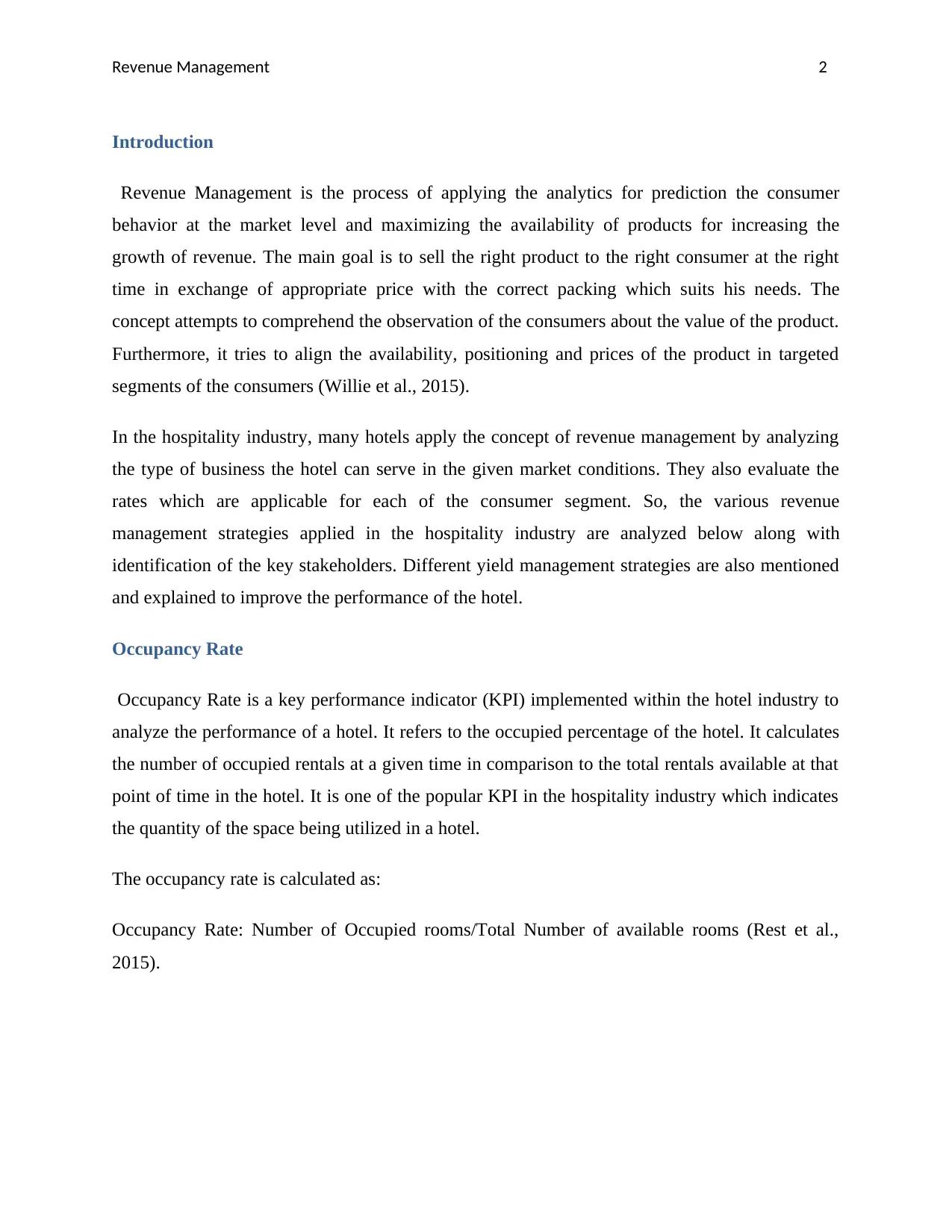
Revenue Management 2
Introduction
Revenue Management is the process of applying the analytics for prediction the consumer
behavior at the market level and maximizing the availability of products for increasing the
growth of revenue. The main goal is to sell the right product to the right consumer at the right
time in exchange of appropriate price with the correct packing which suits his needs. The
concept attempts to comprehend the observation of the consumers about the value of the product.
Furthermore, it tries to align the availability, positioning and prices of the product in targeted
segments of the consumers (Willie et al., 2015).
In the hospitality industry, many hotels apply the concept of revenue management by analyzing
the type of business the hotel can serve in the given market conditions. They also evaluate the
rates which are applicable for each of the consumer segment. So, the various revenue
management strategies applied in the hospitality industry are analyzed below along with
identification of the key stakeholders. Different yield management strategies are also mentioned
and explained to improve the performance of the hotel.
Occupancy Rate
Occupancy Rate is a key performance indicator (KPI) implemented within the hotel industry to
analyze the performance of a hotel. It refers to the occupied percentage of the hotel. It calculates
the number of occupied rentals at a given time in comparison to the total rentals available at that
point of time in the hotel. It is one of the popular KPI in the hospitality industry which indicates
the quantity of the space being utilized in a hotel.
The occupancy rate is calculated as:
Occupancy Rate: Number of Occupied rooms/Total Number of available rooms (Rest et al.,
2015).
Introduction
Revenue Management is the process of applying the analytics for prediction the consumer
behavior at the market level and maximizing the availability of products for increasing the
growth of revenue. The main goal is to sell the right product to the right consumer at the right
time in exchange of appropriate price with the correct packing which suits his needs. The
concept attempts to comprehend the observation of the consumers about the value of the product.
Furthermore, it tries to align the availability, positioning and prices of the product in targeted
segments of the consumers (Willie et al., 2015).
In the hospitality industry, many hotels apply the concept of revenue management by analyzing
the type of business the hotel can serve in the given market conditions. They also evaluate the
rates which are applicable for each of the consumer segment. So, the various revenue
management strategies applied in the hospitality industry are analyzed below along with
identification of the key stakeholders. Different yield management strategies are also mentioned
and explained to improve the performance of the hotel.
Occupancy Rate
Occupancy Rate is a key performance indicator (KPI) implemented within the hotel industry to
analyze the performance of a hotel. It refers to the occupied percentage of the hotel. It calculates
the number of occupied rentals at a given time in comparison to the total rentals available at that
point of time in the hotel. It is one of the popular KPI in the hospitality industry which indicates
the quantity of the space being utilized in a hotel.
The occupancy rate is calculated as:
Occupancy Rate: Number of Occupied rooms/Total Number of available rooms (Rest et al.,
2015).
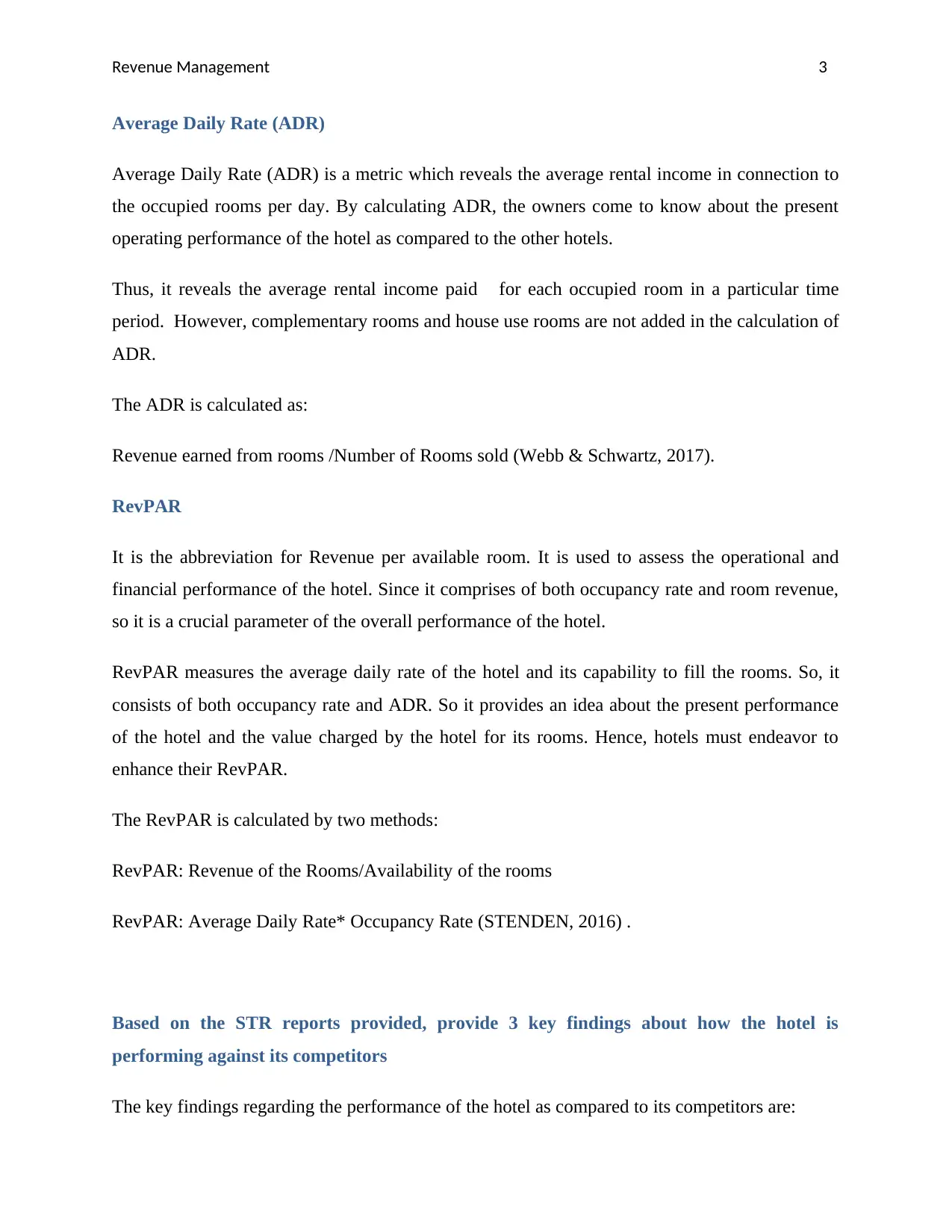
Revenue Management 3
Average Daily Rate (ADR)
Average Daily Rate (ADR) is a metric which reveals the average rental income in connection to
the occupied rooms per day. By calculating ADR, the owners come to know about the present
operating performance of the hotel as compared to the other hotels.
Thus, it reveals the average rental income paid for each occupied room in a particular time
period. However, complementary rooms and house use rooms are not added in the calculation of
ADR.
The ADR is calculated as:
Revenue earned from rooms /Number of Rooms sold (Webb & Schwartz, 2017).
RevPAR
It is the abbreviation for Revenue per available room. It is used to assess the operational and
financial performance of the hotel. Since it comprises of both occupancy rate and room revenue,
so it is a crucial parameter of the overall performance of the hotel.
RevPAR measures the average daily rate of the hotel and its capability to fill the rooms. So, it
consists of both occupancy rate and ADR. So it provides an idea about the present performance
of the hotel and the value charged by the hotel for its rooms. Hence, hotels must endeavor to
enhance their RevPAR.
The RevPAR is calculated by two methods:
RevPAR: Revenue of the Rooms/Availability of the rooms
RevPAR: Average Daily Rate* Occupancy Rate (STENDEN, 2016) .
Based on the STR reports provided, provide 3 key findings about how the hotel is
performing against its competitors
The key findings regarding the performance of the hotel as compared to its competitors are:
Average Daily Rate (ADR)
Average Daily Rate (ADR) is a metric which reveals the average rental income in connection to
the occupied rooms per day. By calculating ADR, the owners come to know about the present
operating performance of the hotel as compared to the other hotels.
Thus, it reveals the average rental income paid for each occupied room in a particular time
period. However, complementary rooms and house use rooms are not added in the calculation of
ADR.
The ADR is calculated as:
Revenue earned from rooms /Number of Rooms sold (Webb & Schwartz, 2017).
RevPAR
It is the abbreviation for Revenue per available room. It is used to assess the operational and
financial performance of the hotel. Since it comprises of both occupancy rate and room revenue,
so it is a crucial parameter of the overall performance of the hotel.
RevPAR measures the average daily rate of the hotel and its capability to fill the rooms. So, it
consists of both occupancy rate and ADR. So it provides an idea about the present performance
of the hotel and the value charged by the hotel for its rooms. Hence, hotels must endeavor to
enhance their RevPAR.
The RevPAR is calculated by two methods:
RevPAR: Revenue of the Rooms/Availability of the rooms
RevPAR: Average Daily Rate* Occupancy Rate (STENDEN, 2016) .
Based on the STR reports provided, provide 3 key findings about how the hotel is
performing against its competitors
The key findings regarding the performance of the hotel as compared to its competitors are:
Secure Best Marks with AI Grader
Need help grading? Try our AI Grader for instant feedback on your assignments.
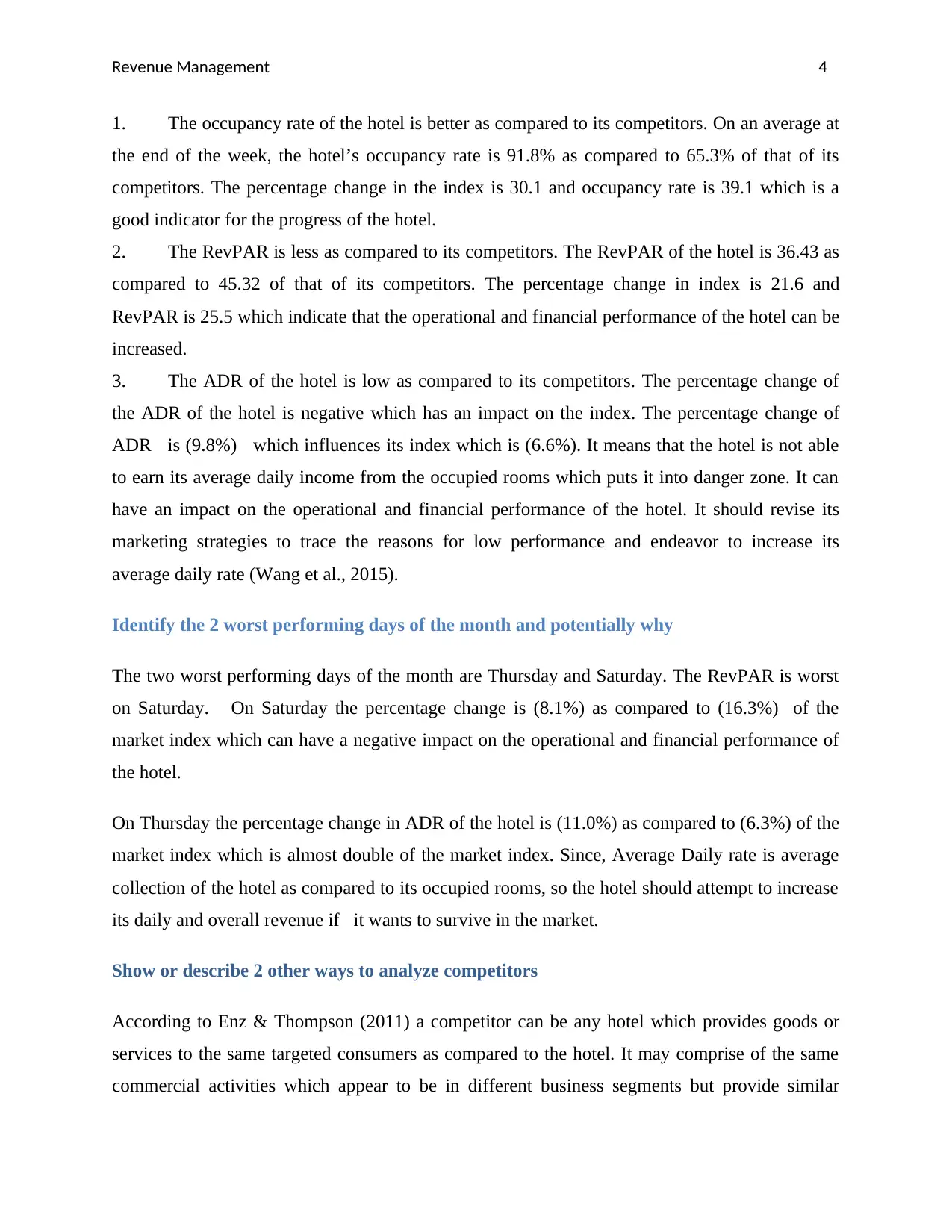
Revenue Management 4
1. The occupancy rate of the hotel is better as compared to its competitors. On an average at
the end of the week, the hotel’s occupancy rate is 91.8% as compared to 65.3% of that of its
competitors. The percentage change in the index is 30.1 and occupancy rate is 39.1 which is a
good indicator for the progress of the hotel.
2. The RevPAR is less as compared to its competitors. The RevPAR of the hotel is 36.43 as
compared to 45.32 of that of its competitors. The percentage change in index is 21.6 and
RevPAR is 25.5 which indicate that the operational and financial performance of the hotel can be
increased.
3. The ADR of the hotel is low as compared to its competitors. The percentage change of
the ADR of the hotel is negative which has an impact on the index. The percentage change of
ADR is (9.8%) which influences its index which is (6.6%). It means that the hotel is not able
to earn its average daily income from the occupied rooms which puts it into danger zone. It can
have an impact on the operational and financial performance of the hotel. It should revise its
marketing strategies to trace the reasons for low performance and endeavor to increase its
average daily rate (Wang et al., 2015).
Identify the 2 worst performing days of the month and potentially why
The two worst performing days of the month are Thursday and Saturday. The RevPAR is worst
on Saturday. On Saturday the percentage change is (8.1%) as compared to (16.3%) of the
market index which can have a negative impact on the operational and financial performance of
the hotel.
On Thursday the percentage change in ADR of the hotel is (11.0%) as compared to (6.3%) of the
market index which is almost double of the market index. Since, Average Daily rate is average
collection of the hotel as compared to its occupied rooms, so the hotel should attempt to increase
its daily and overall revenue if it wants to survive in the market.
Show or describe 2 other ways to analyze competitors
According to Enz & Thompson (2011) a competitor can be any hotel which provides goods or
services to the same targeted consumers as compared to the hotel. It may comprise of the same
commercial activities which appear to be in different business segments but provide similar
1. The occupancy rate of the hotel is better as compared to its competitors. On an average at
the end of the week, the hotel’s occupancy rate is 91.8% as compared to 65.3% of that of its
competitors. The percentage change in the index is 30.1 and occupancy rate is 39.1 which is a
good indicator for the progress of the hotel.
2. The RevPAR is less as compared to its competitors. The RevPAR of the hotel is 36.43 as
compared to 45.32 of that of its competitors. The percentage change in index is 21.6 and
RevPAR is 25.5 which indicate that the operational and financial performance of the hotel can be
increased.
3. The ADR of the hotel is low as compared to its competitors. The percentage change of
the ADR of the hotel is negative which has an impact on the index. The percentage change of
ADR is (9.8%) which influences its index which is (6.6%). It means that the hotel is not able
to earn its average daily income from the occupied rooms which puts it into danger zone. It can
have an impact on the operational and financial performance of the hotel. It should revise its
marketing strategies to trace the reasons for low performance and endeavor to increase its
average daily rate (Wang et al., 2015).
Identify the 2 worst performing days of the month and potentially why
The two worst performing days of the month are Thursday and Saturday. The RevPAR is worst
on Saturday. On Saturday the percentage change is (8.1%) as compared to (16.3%) of the
market index which can have a negative impact on the operational and financial performance of
the hotel.
On Thursday the percentage change in ADR of the hotel is (11.0%) as compared to (6.3%) of the
market index which is almost double of the market index. Since, Average Daily rate is average
collection of the hotel as compared to its occupied rooms, so the hotel should attempt to increase
its daily and overall revenue if it wants to survive in the market.
Show or describe 2 other ways to analyze competitors
According to Enz & Thompson (2011) a competitor can be any hotel which provides goods or
services to the same targeted consumers as compared to the hotel. It may comprise of the same
commercial activities which appear to be in different business segments but provide similar
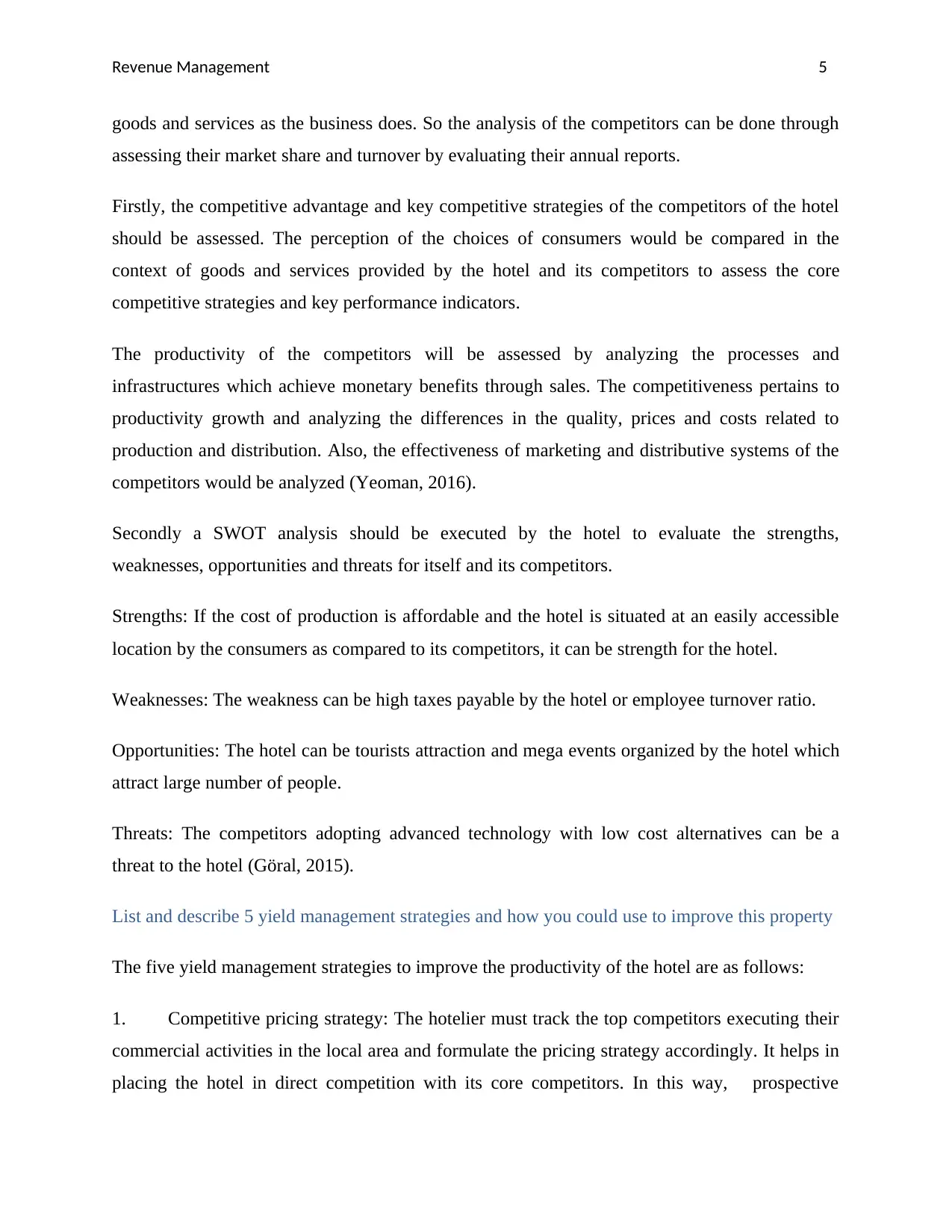
Revenue Management 5
goods and services as the business does. So the analysis of the competitors can be done through
assessing their market share and turnover by evaluating their annual reports.
Firstly, the competitive advantage and key competitive strategies of the competitors of the hotel
should be assessed. The perception of the choices of consumers would be compared in the
context of goods and services provided by the hotel and its competitors to assess the core
competitive strategies and key performance indicators.
The productivity of the competitors will be assessed by analyzing the processes and
infrastructures which achieve monetary benefits through sales. The competitiveness pertains to
productivity growth and analyzing the differences in the quality, prices and costs related to
production and distribution. Also, the effectiveness of marketing and distributive systems of the
competitors would be analyzed (Yeoman, 2016).
Secondly a SWOT analysis should be executed by the hotel to evaluate the strengths,
weaknesses, opportunities and threats for itself and its competitors.
Strengths: If the cost of production is affordable and the hotel is situated at an easily accessible
location by the consumers as compared to its competitors, it can be strength for the hotel.
Weaknesses: The weakness can be high taxes payable by the hotel or employee turnover ratio.
Opportunities: The hotel can be tourists attraction and mega events organized by the hotel which
attract large number of people.
Threats: The competitors adopting advanced technology with low cost alternatives can be a
threat to the hotel (Göral, 2015).
List and describe 5 yield management strategies and how you could use to improve this property
The five yield management strategies to improve the productivity of the hotel are as follows:
1. Competitive pricing strategy: The hotelier must track the top competitors executing their
commercial activities in the local area and formulate the pricing strategy accordingly. It helps in
placing the hotel in direct competition with its core competitors. In this way, prospective
goods and services as the business does. So the analysis of the competitors can be done through
assessing their market share and turnover by evaluating their annual reports.
Firstly, the competitive advantage and key competitive strategies of the competitors of the hotel
should be assessed. The perception of the choices of consumers would be compared in the
context of goods and services provided by the hotel and its competitors to assess the core
competitive strategies and key performance indicators.
The productivity of the competitors will be assessed by analyzing the processes and
infrastructures which achieve monetary benefits through sales. The competitiveness pertains to
productivity growth and analyzing the differences in the quality, prices and costs related to
production and distribution. Also, the effectiveness of marketing and distributive systems of the
competitors would be analyzed (Yeoman, 2016).
Secondly a SWOT analysis should be executed by the hotel to evaluate the strengths,
weaknesses, opportunities and threats for itself and its competitors.
Strengths: If the cost of production is affordable and the hotel is situated at an easily accessible
location by the consumers as compared to its competitors, it can be strength for the hotel.
Weaknesses: The weakness can be high taxes payable by the hotel or employee turnover ratio.
Opportunities: The hotel can be tourists attraction and mega events organized by the hotel which
attract large number of people.
Threats: The competitors adopting advanced technology with low cost alternatives can be a
threat to the hotel (Göral, 2015).
List and describe 5 yield management strategies and how you could use to improve this property
The five yield management strategies to improve the productivity of the hotel are as follows:
1. Competitive pricing strategy: The hotelier must track the top competitors executing their
commercial activities in the local area and formulate the pricing strategy accordingly. It helps in
placing the hotel in direct competition with its core competitors. In this way, prospective
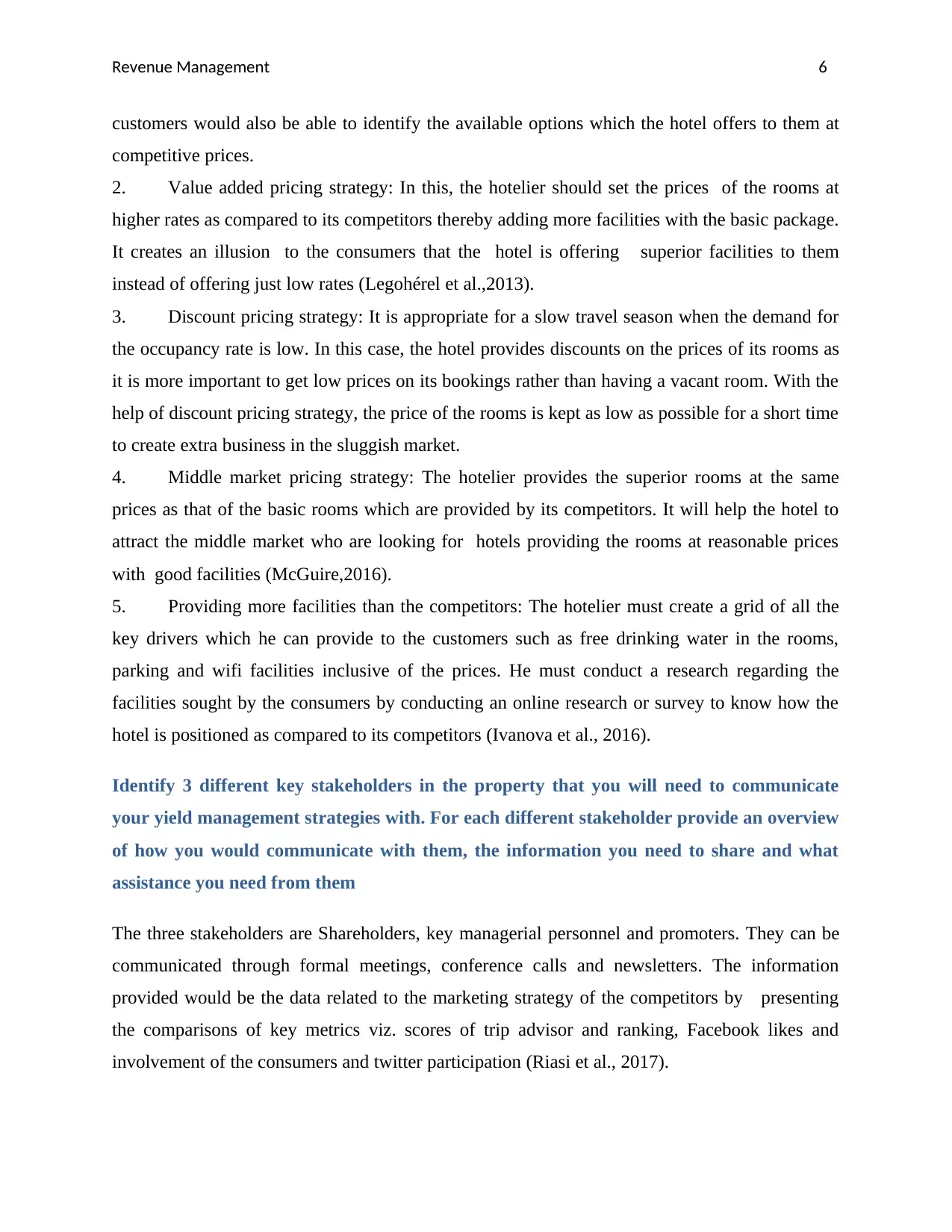
Revenue Management 6
customers would also be able to identify the available options which the hotel offers to them at
competitive prices.
2. Value added pricing strategy: In this, the hotelier should set the prices of the rooms at
higher rates as compared to its competitors thereby adding more facilities with the basic package.
It creates an illusion to the consumers that the hotel is offering superior facilities to them
instead of offering just low rates (Legohérel et al.,2013).
3. Discount pricing strategy: It is appropriate for a slow travel season when the demand for
the occupancy rate is low. In this case, the hotel provides discounts on the prices of its rooms as
it is more important to get low prices on its bookings rather than having a vacant room. With the
help of discount pricing strategy, the price of the rooms is kept as low as possible for a short time
to create extra business in the sluggish market.
4. Middle market pricing strategy: The hotelier provides the superior rooms at the same
prices as that of the basic rooms which are provided by its competitors. It will help the hotel to
attract the middle market who are looking for hotels providing the rooms at reasonable prices
with good facilities (McGuire,2016).
5. Providing more facilities than the competitors: The hotelier must create a grid of all the
key drivers which he can provide to the customers such as free drinking water in the rooms,
parking and wifi facilities inclusive of the prices. He must conduct a research regarding the
facilities sought by the consumers by conducting an online research or survey to know how the
hotel is positioned as compared to its competitors (Ivanova et al., 2016).
Identify 3 different key stakeholders in the property that you will need to communicate
your yield management strategies with. For each different stakeholder provide an overview
of how you would communicate with them, the information you need to share and what
assistance you need from them
The three stakeholders are Shareholders, key managerial personnel and promoters. They can be
communicated through formal meetings, conference calls and newsletters. The information
provided would be the data related to the marketing strategy of the competitors by presenting
the comparisons of key metrics viz. scores of trip advisor and ranking, Facebook likes and
involvement of the consumers and twitter participation (Riasi et al., 2017).
customers would also be able to identify the available options which the hotel offers to them at
competitive prices.
2. Value added pricing strategy: In this, the hotelier should set the prices of the rooms at
higher rates as compared to its competitors thereby adding more facilities with the basic package.
It creates an illusion to the consumers that the hotel is offering superior facilities to them
instead of offering just low rates (Legohérel et al.,2013).
3. Discount pricing strategy: It is appropriate for a slow travel season when the demand for
the occupancy rate is low. In this case, the hotel provides discounts on the prices of its rooms as
it is more important to get low prices on its bookings rather than having a vacant room. With the
help of discount pricing strategy, the price of the rooms is kept as low as possible for a short time
to create extra business in the sluggish market.
4. Middle market pricing strategy: The hotelier provides the superior rooms at the same
prices as that of the basic rooms which are provided by its competitors. It will help the hotel to
attract the middle market who are looking for hotels providing the rooms at reasonable prices
with good facilities (McGuire,2016).
5. Providing more facilities than the competitors: The hotelier must create a grid of all the
key drivers which he can provide to the customers such as free drinking water in the rooms,
parking and wifi facilities inclusive of the prices. He must conduct a research regarding the
facilities sought by the consumers by conducting an online research or survey to know how the
hotel is positioned as compared to its competitors (Ivanova et al., 2016).
Identify 3 different key stakeholders in the property that you will need to communicate
your yield management strategies with. For each different stakeholder provide an overview
of how you would communicate with them, the information you need to share and what
assistance you need from them
The three stakeholders are Shareholders, key managerial personnel and promoters. They can be
communicated through formal meetings, conference calls and newsletters. The information
provided would be the data related to the marketing strategy of the competitors by presenting
the comparisons of key metrics viz. scores of trip advisor and ranking, Facebook likes and
involvement of the consumers and twitter participation (Riasi et al., 2017).
Paraphrase This Document
Need a fresh take? Get an instant paraphrase of this document with our AI Paraphraser
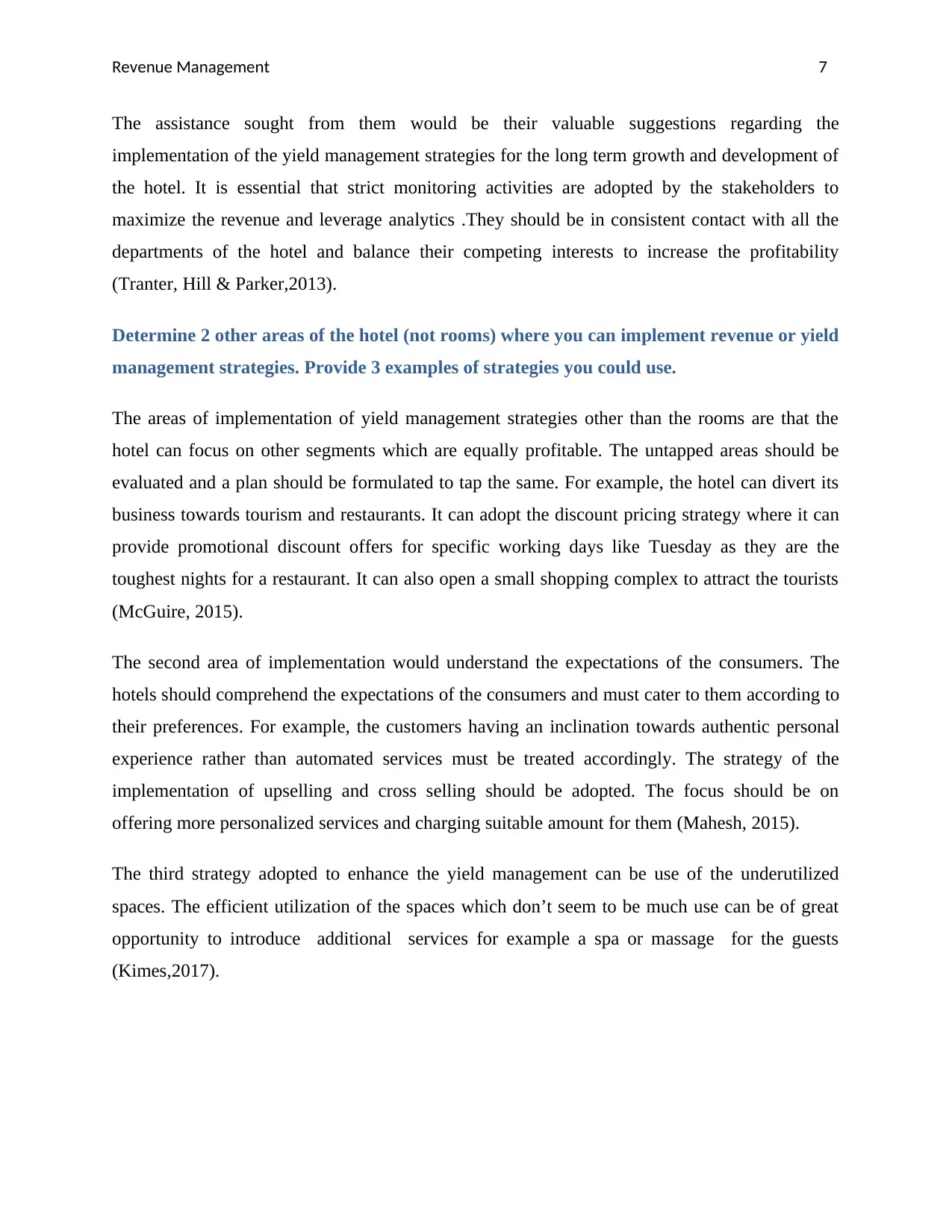
Revenue Management 7
The assistance sought from them would be their valuable suggestions regarding the
implementation of the yield management strategies for the long term growth and development of
the hotel. It is essential that strict monitoring activities are adopted by the stakeholders to
maximize the revenue and leverage analytics .They should be in consistent contact with all the
departments of the hotel and balance their competing interests to increase the profitability
(Tranter, Hill & Parker,2013).
Determine 2 other areas of the hotel (not rooms) where you can implement revenue or yield
management strategies. Provide 3 examples of strategies you could use.
The areas of implementation of yield management strategies other than the rooms are that the
hotel can focus on other segments which are equally profitable. The untapped areas should be
evaluated and a plan should be formulated to tap the same. For example, the hotel can divert its
business towards tourism and restaurants. It can adopt the discount pricing strategy where it can
provide promotional discount offers for specific working days like Tuesday as they are the
toughest nights for a restaurant. It can also open a small shopping complex to attract the tourists
(McGuire, 2015).
The second area of implementation would understand the expectations of the consumers. The
hotels should comprehend the expectations of the consumers and must cater to them according to
their preferences. For example, the customers having an inclination towards authentic personal
experience rather than automated services must be treated accordingly. The strategy of the
implementation of upselling and cross selling should be adopted. The focus should be on
offering more personalized services and charging suitable amount for them (Mahesh, 2015).
The third strategy adopted to enhance the yield management can be use of the underutilized
spaces. The efficient utilization of the spaces which don’t seem to be much use can be of great
opportunity to introduce additional services for example a spa or massage for the guests
(Kimes,2017).
The assistance sought from them would be their valuable suggestions regarding the
implementation of the yield management strategies for the long term growth and development of
the hotel. It is essential that strict monitoring activities are adopted by the stakeholders to
maximize the revenue and leverage analytics .They should be in consistent contact with all the
departments of the hotel and balance their competing interests to increase the profitability
(Tranter, Hill & Parker,2013).
Determine 2 other areas of the hotel (not rooms) where you can implement revenue or yield
management strategies. Provide 3 examples of strategies you could use.
The areas of implementation of yield management strategies other than the rooms are that the
hotel can focus on other segments which are equally profitable. The untapped areas should be
evaluated and a plan should be formulated to tap the same. For example, the hotel can divert its
business towards tourism and restaurants. It can adopt the discount pricing strategy where it can
provide promotional discount offers for specific working days like Tuesday as they are the
toughest nights for a restaurant. It can also open a small shopping complex to attract the tourists
(McGuire, 2015).
The second area of implementation would understand the expectations of the consumers. The
hotels should comprehend the expectations of the consumers and must cater to them according to
their preferences. For example, the customers having an inclination towards authentic personal
experience rather than automated services must be treated accordingly. The strategy of the
implementation of upselling and cross selling should be adopted. The focus should be on
offering more personalized services and charging suitable amount for them (Mahesh, 2015).
The third strategy adopted to enhance the yield management can be use of the underutilized
spaces. The efficient utilization of the spaces which don’t seem to be much use can be of great
opportunity to introduce additional services for example a spa or massage for the guests
(Kimes,2017).
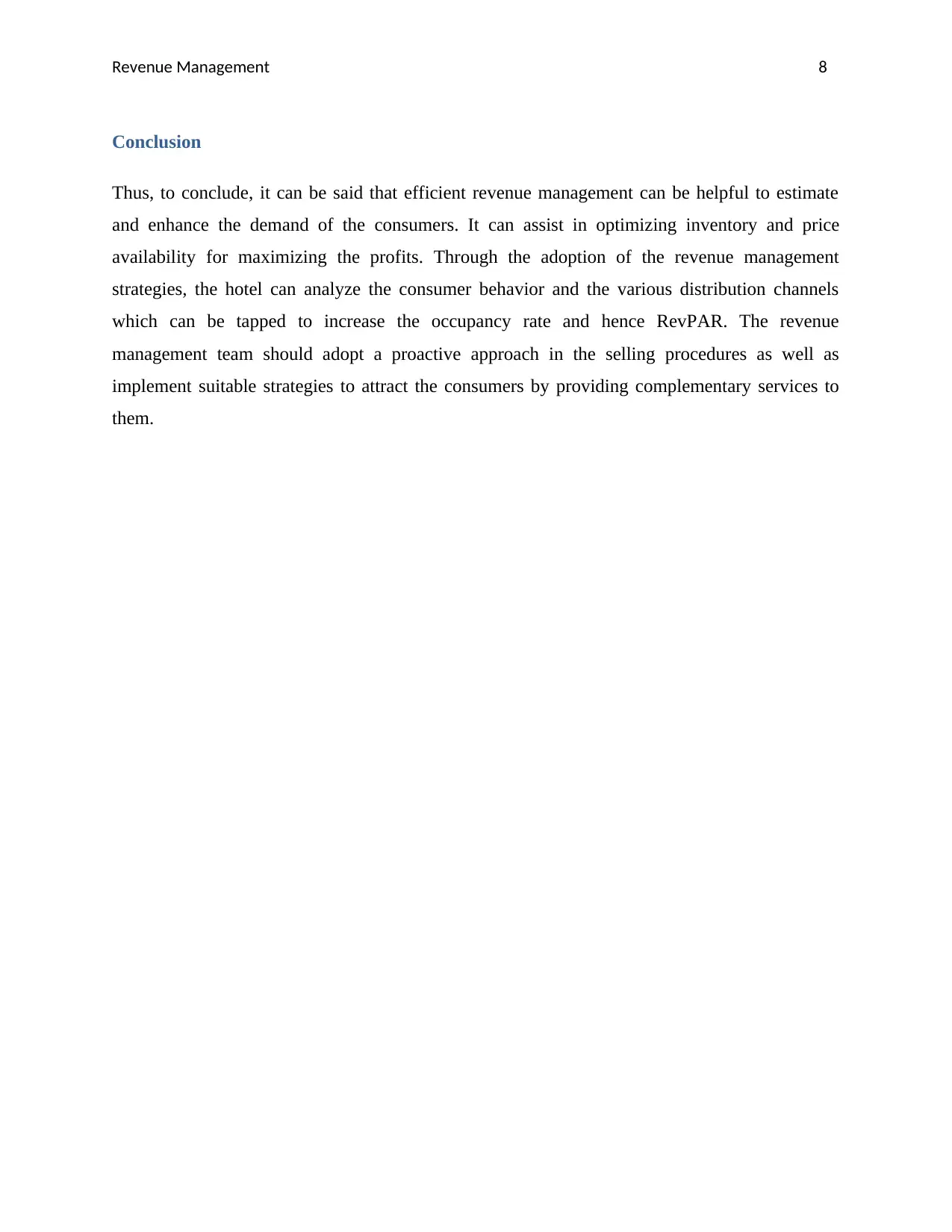
Revenue Management 8
Conclusion
Thus, to conclude, it can be said that efficient revenue management can be helpful to estimate
and enhance the demand of the consumers. It can assist in optimizing inventory and price
availability for maximizing the profits. Through the adoption of the revenue management
strategies, the hotel can analyze the consumer behavior and the various distribution channels
which can be tapped to increase the occupancy rate and hence RevPAR. The revenue
management team should adopt a proactive approach in the selling procedures as well as
implement suitable strategies to attract the consumers by providing complementary services to
them.
Conclusion
Thus, to conclude, it can be said that efficient revenue management can be helpful to estimate
and enhance the demand of the consumers. It can assist in optimizing inventory and price
availability for maximizing the profits. Through the adoption of the revenue management
strategies, the hotel can analyze the consumer behavior and the various distribution channels
which can be tapped to increase the occupancy rate and hence RevPAR. The revenue
management team should adopt a proactive approach in the selling procedures as well as
implement suitable strategies to attract the consumers by providing complementary services to
them.
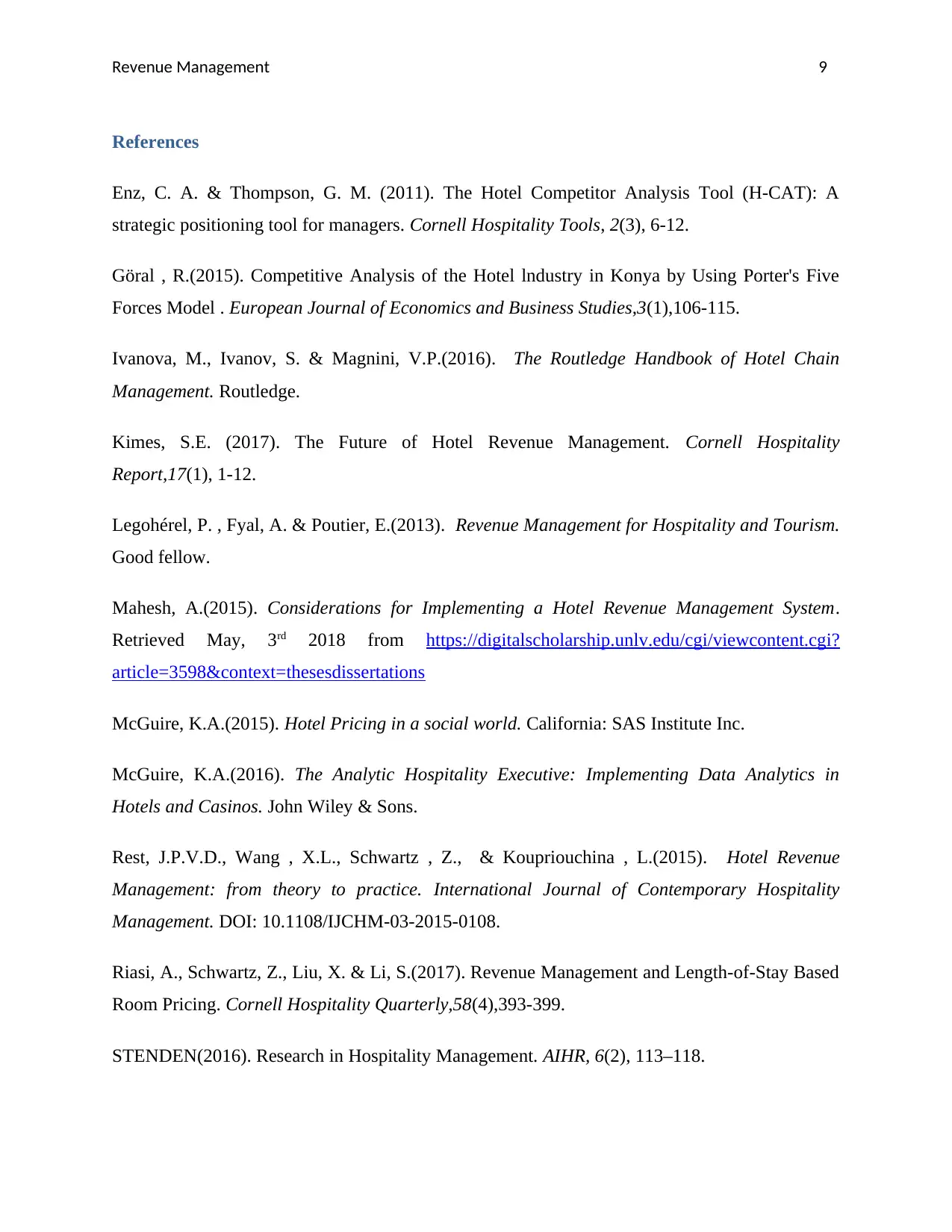
Revenue Management 9
References
Enz, C. A. & Thompson, G. M. (2011). The Hotel Competitor Analysis Tool (H-CAT): A
strategic positioning tool for managers. Cornell Hospitality Tools, 2(3), 6-12.
Göral , R.(2015). Competitive Analysis of the Hotel lndustry in Konya by Using Porter's Five
Forces Model . European Journal of Economics and Business Studies,3(1),106-115.
Ivanova, M., Ivanov, S. & Magnini, V.P.(2016). The Routledge Handbook of Hotel Chain
Management. Routledge.
Kimes, S.E. (2017). The Future of Hotel Revenue Management. Cornell Hospitality
Report,17(1), 1-12.
Legohérel, P. , Fyal, A. & Poutier, E.(2013). Revenue Management for Hospitality and Tourism.
Good fellow.
Mahesh, A.(2015). Considerations for Implementing a Hotel Revenue Management System.
Retrieved May, 3rd 2018 from https://digitalscholarship.unlv.edu/cgi/viewcontent.cgi?
article=3598&context=thesesdissertations
McGuire, K.A.(2015). Hotel Pricing in a social world. California: SAS Institute Inc.
McGuire, K.A.(2016). The Analytic Hospitality Executive: Implementing Data Analytics in
Hotels and Casinos. John Wiley & Sons.
Rest, J.P.V.D., Wang , X.L., Schwartz , Z., & Koupriouchina , L.(2015). Hotel Revenue
Management: from theory to practice. International Journal of Contemporary Hospitality
Management. DOI: 10.1108/IJCHM-03-2015-0108.
Riasi, A., Schwartz, Z., Liu, X. & Li, S.(2017). Revenue Management and Length-of-Stay Based
Room Pricing. Cornell Hospitality Quarterly,58(4),393-399.
STENDEN(2016). Research in Hospitality Management. AIHR, 6(2), 113–118.
References
Enz, C. A. & Thompson, G. M. (2011). The Hotel Competitor Analysis Tool (H-CAT): A
strategic positioning tool for managers. Cornell Hospitality Tools, 2(3), 6-12.
Göral , R.(2015). Competitive Analysis of the Hotel lndustry in Konya by Using Porter's Five
Forces Model . European Journal of Economics and Business Studies,3(1),106-115.
Ivanova, M., Ivanov, S. & Magnini, V.P.(2016). The Routledge Handbook of Hotel Chain
Management. Routledge.
Kimes, S.E. (2017). The Future of Hotel Revenue Management. Cornell Hospitality
Report,17(1), 1-12.
Legohérel, P. , Fyal, A. & Poutier, E.(2013). Revenue Management for Hospitality and Tourism.
Good fellow.
Mahesh, A.(2015). Considerations for Implementing a Hotel Revenue Management System.
Retrieved May, 3rd 2018 from https://digitalscholarship.unlv.edu/cgi/viewcontent.cgi?
article=3598&context=thesesdissertations
McGuire, K.A.(2015). Hotel Pricing in a social world. California: SAS Institute Inc.
McGuire, K.A.(2016). The Analytic Hospitality Executive: Implementing Data Analytics in
Hotels and Casinos. John Wiley & Sons.
Rest, J.P.V.D., Wang , X.L., Schwartz , Z., & Koupriouchina , L.(2015). Hotel Revenue
Management: from theory to practice. International Journal of Contemporary Hospitality
Management. DOI: 10.1108/IJCHM-03-2015-0108.
Riasi, A., Schwartz, Z., Liu, X. & Li, S.(2017). Revenue Management and Length-of-Stay Based
Room Pricing. Cornell Hospitality Quarterly,58(4),393-399.
STENDEN(2016). Research in Hospitality Management. AIHR, 6(2), 113–118.
Secure Best Marks with AI Grader
Need help grading? Try our AI Grader for instant feedback on your assignments.
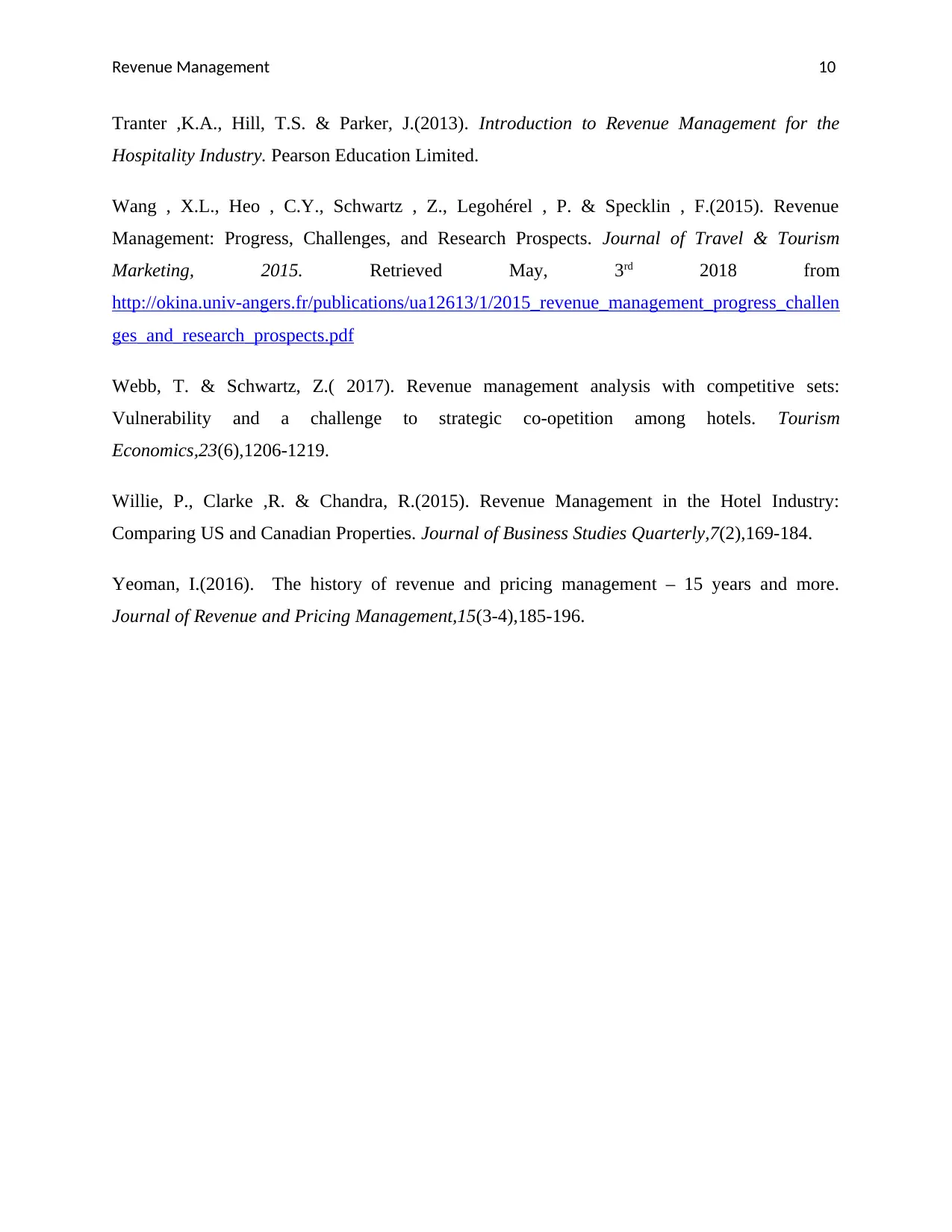
Revenue Management 10
Tranter ,K.A., Hill, T.S. & Parker, J.(2013). Introduction to Revenue Management for the
Hospitality Industry. Pearson Education Limited.
Wang , X.L., Heo , C.Y., Schwartz , Z., Legohérel , P. & Specklin , F.(2015). Revenue
Management: Progress, Challenges, and Research Prospects. Journal of Travel & Tourism
Marketing, 2015. Retrieved May, 3rd 2018 from
http://okina.univ-angers.fr/publications/ua12613/1/2015_revenue_management_progress_challen
ges_and_research_prospects.pdf
Webb, T. & Schwartz, Z.( 2017). Revenue management analysis with competitive sets:
Vulnerability and a challenge to strategic co-opetition among hotels. Tourism
Economics,23(6),1206-1219.
Willie, P., Clarke ,R. & Chandra, R.(2015). Revenue Management in the Hotel Industry:
Comparing US and Canadian Properties. Journal of Business Studies Quarterly,7(2),169-184.
Yeoman, I.(2016). The history of revenue and pricing management – 15 years and more.
Journal of Revenue and Pricing Management,15(3-4),185-196.
Tranter ,K.A., Hill, T.S. & Parker, J.(2013). Introduction to Revenue Management for the
Hospitality Industry. Pearson Education Limited.
Wang , X.L., Heo , C.Y., Schwartz , Z., Legohérel , P. & Specklin , F.(2015). Revenue
Management: Progress, Challenges, and Research Prospects. Journal of Travel & Tourism
Marketing, 2015. Retrieved May, 3rd 2018 from
http://okina.univ-angers.fr/publications/ua12613/1/2015_revenue_management_progress_challen
ges_and_research_prospects.pdf
Webb, T. & Schwartz, Z.( 2017). Revenue management analysis with competitive sets:
Vulnerability and a challenge to strategic co-opetition among hotels. Tourism
Economics,23(6),1206-1219.
Willie, P., Clarke ,R. & Chandra, R.(2015). Revenue Management in the Hotel Industry:
Comparing US and Canadian Properties. Journal of Business Studies Quarterly,7(2),169-184.
Yeoman, I.(2016). The history of revenue and pricing management – 15 years and more.
Journal of Revenue and Pricing Management,15(3-4),185-196.
1 out of 11
Related Documents
Your All-in-One AI-Powered Toolkit for Academic Success.
+13062052269
info@desklib.com
Available 24*7 on WhatsApp / Email
![[object Object]](/_next/static/media/star-bottom.7253800d.svg)
Unlock your academic potential
© 2024 | Zucol Services PVT LTD | All rights reserved.





